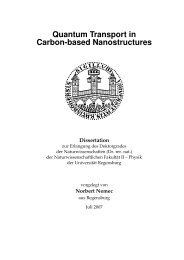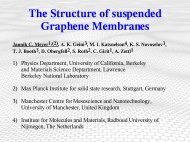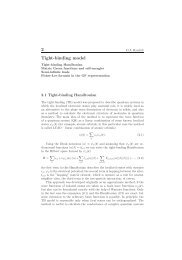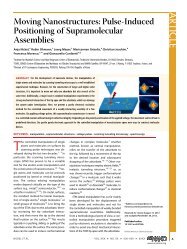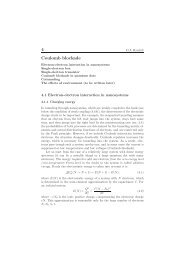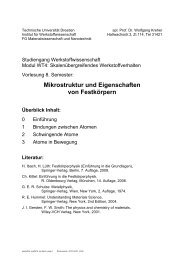Efficient linear scaling method for computing the thermal conductivity ...
Efficient linear scaling method for computing the thermal conductivity ...
Efficient linear scaling method for computing the thermal conductivity ...
You also want an ePaper? Increase the reach of your titles
YUMPU automatically turns print PDFs into web optimized ePapers that Google loves.
LI, SEVINÇLI, ROCHE, AND CUNIBERTI PHYSICAL REVIEW B 83, 155416 (2011)<br />
of <strong>the</strong> Lanczos <strong>method</strong> <strong>for</strong> <strong>computing</strong> <strong>the</strong> Landauer-Büttiker<br />
conductance of low-dimensional systems was also reported. 30<br />
In this paper, we first extend our recent communication<br />
on <strong>the</strong> <strong>method</strong> 31 to a complete derivation of <strong>the</strong> phonon<br />
transmission coefficient starting from <strong>the</strong> original Kubo<br />
<strong>for</strong>mula and within <strong>the</strong> harmonic approximation. This means<br />
that only elastic scattering (due, <strong>for</strong> instance, to isotope<br />
disorder) is introduced, disregarding anharmonic effects. The<br />
study of <strong>the</strong> dynamical properties of phonon wave packets<br />
is also related to <strong>the</strong> <strong>the</strong>rmal conductance, which requires a<br />
phonon frequency integration over <strong>the</strong> whole spectrum. We<br />
<strong>the</strong>n validate <strong>the</strong> <strong>method</strong> by comparison with o<strong>the</strong>r numerical<br />
approaches and analytical results, and we fur<strong>the</strong>r apply this<br />
<strong>method</strong> to edge-disordered GNRs and discuss its limits.<br />
II. COMPUTATIONAL PHONON TRANSPORT<br />
METHODOLOGY<br />
The electronic transport <strong>the</strong>ory in <strong>the</strong> <strong>linear</strong> response regime<br />
generally relies on <strong>the</strong> approach derived by Kubo. 32 To investigate<br />
bulk quantum phonon transport in disordered materials,<br />
<strong>the</strong> use of <strong>the</strong> Kubo <strong>for</strong>malism turns out to be <strong>the</strong> most natural<br />
and computationally efficient one. It has already been used <strong>for</strong><br />
investigating <strong>the</strong>rmal transport in disordered binary alloys or<br />
nanocrystalline silicon. 33,34 Inspired by <strong>the</strong> MKRT scheme <strong>for</strong><br />
electron transport, 20 we derive a real-space implementation of<br />
<strong>the</strong> Kubo <strong>for</strong>mula <strong>for</strong> phonon propagation, which establishes<br />
a direct computational bridge between phonon dynamics and<br />
<strong>the</strong>rmal conductance. In contrast to o<strong>the</strong>r implementations of<br />
<strong>the</strong> Kubo approach, we extract dynamical in<strong>for</strong>mation from <strong>the</strong><br />
time evolution of <strong>the</strong> wave packet 35 (based on <strong>the</strong> expansion of<br />
<strong>the</strong> evolution operator on a Chebyshev polynomials basis) and<br />
simulate quantum dynamics instead of solving <strong>the</strong> Newtonian<br />
equations of motion. 36–38 There<strong>for</strong>e, a single initial condition is<br />
enough (i.e., <strong>the</strong> initial atomic displacements) without any need<br />
to compute <strong>the</strong> time-dependent atomic velocities. Additionally,<br />
by using <strong>the</strong> Lanczos technique, one can avoid any matrix<br />
inversions, and a considerable gain in computational efficiency<br />
is obtained, which allows <strong>the</strong> study of very large-scale<br />
materials.<br />
A. Derivation of <strong>the</strong> phonon transport equations<br />
The vibrational Hamiltonian, taking only <strong>the</strong> harmonic<br />
interactions into account, is described as<br />
H = ˆp<br />
i<br />
2 i<br />
+<br />
2Mi<br />
<br />
ij ûiûj , (1)<br />
ij<br />
where ûi and ˆpi are <strong>the</strong> displacement and momentum operators<br />
<strong>for</strong> <strong>the</strong> ith atomic degree of freedom, Mi is <strong>the</strong> corresponding<br />
mass, and is <strong>the</strong> <strong>for</strong>ce constant tensor. Based on <strong>the</strong><br />
<strong>linear</strong> response <strong>the</strong>ory, <strong>the</strong> phonon <strong>conductivity</strong> σ along <strong>the</strong> x<br />
direction can be obtained as34 σ = T −1 β ∞<br />
lim lim dλ dt e<br />
ω→0 η→0 0 0<br />
i(ω+iη)t 〈 Jˆ x (−i¯hλ) Jˆ x (t)〉,<br />
(2)<br />
with being <strong>the</strong> system volume and T being <strong>the</strong> temperature;<br />
Jˆ x is <strong>the</strong> x component of <strong>the</strong> energy flux operator ˆJ, and it can<br />
be expressed as Jˆ x = 1/2 <br />
ij (Xi − Xj )ij ûi ˆvj , where ˆvj<br />
is <strong>the</strong> velocity operator and Xi is <strong>the</strong> equilibrium position of<br />
<strong>the</strong> atom to which <strong>the</strong> ith degree of freedom belongs. After<br />
neglecting terms like â † mâ † n and âmân, Jˆ x can be rewritten in<br />
terms of <strong>the</strong> phonon creation and annihilation operators as<br />
Jˆ x = <br />
m,n J x mn↠mân, where<br />
J x mn =−i¯h<br />
<br />
ωm ωn<br />
+ 〈m|[X,D]|n〉. (3)<br />
4 ωn ωm<br />
In Eq. (3), X is <strong>the</strong> diagonal matrix of equilibrium positions,<br />
D is <strong>the</strong> mass normalized dynamical matrix with Dij =<br />
ij / MiMj , and |n〉 is <strong>the</strong> nth eigenstate of D. Allen and<br />
Feldman have shown that Eq. (2) can be written as34 σ = π ∂fB<br />
J<br />
¯hT ∂ωm m,n<br />
x mnJ x nmδ(ωm − ωn), (4)<br />
where fB is <strong>the</strong> Bose distribution function. There<strong>for</strong>e, one has<br />
σ =− π<br />
∞<br />
dω<br />
0<br />
¯h ∂fB<br />
4ω ∂T<br />
× Tr{[ ˆX,D]δ(ω − √ D)[ ˆX,D]δ(ω − √ D)}, (5)<br />
where √ D = <br />
n ωn|n〉〈n| acts as <strong>the</strong> free particle Hamiltonian,<br />
δ(···) is <strong>the</strong> Dirac delta function, and Tr{···}stands <strong>for</strong><br />
<strong>the</strong> trace operator. Defining Vx =−i[X, √ D], one can write<br />
<strong>the</strong> <strong>the</strong>rmal conductance of a one-dimensional system as<br />
κ = π<br />
L2 ∞<br />
dω¯hω<br />
0<br />
∂fB<br />
∂T Tr{Vxδ(ω − √ D)Vxδ(ω − √ D)}.<br />
(6)<br />
The <strong>the</strong>rmal conductance can also be derived from <strong>the</strong><br />
Landauer <strong>for</strong>malism39 or <strong>the</strong> nonequilibrium Green’s function<br />
approach40 as<br />
κ = 1<br />
∞<br />
dω¯hω<br />
2π 0<br />
∂fB<br />
T (ω), (7)<br />
∂T<br />
with T (ω) being <strong>the</strong> phonon transmission function. Comparing<br />
<strong>the</strong>se two <strong>for</strong>mulas, we obtain <strong>the</strong> transmission function as<br />
155416-2<br />
2 2π<br />
T (ω) =<br />
L2 Tr{Vxδ(ω − √ D)Vxδ(ω − √ D)}. (8)<br />
The phonon transmission function derived here has exactly <strong>the</strong><br />
same <strong>for</strong>m as <strong>the</strong> electron transmission function derived from<br />
<strong>the</strong> Kubo-Greenwood <strong>for</strong>mula, 20<br />
Tel(E) = 2π 2¯h 2<br />
L2 Tr{ ˆVxδ(E − ˆHel) ˆVxδ(E − ˆHel)}, (9)<br />
where ˆHel is <strong>the</strong> electronic Hamiltonian.<br />
We rewrite <strong>the</strong> Kubo <strong>for</strong>mula in a more convenient <strong>for</strong>m <strong>for</strong><br />
<strong>the</strong> real-space study of <strong>the</strong> wave-packet dynamics. Expressing<br />
<strong>the</strong> δ-function as<br />
δ(ω − √ D) = 1<br />
∞<br />
dt e<br />
2π −∞<br />
i(ω−√D)t , (10)<br />
one can <strong>the</strong>n rewrite T (ω)L2 /π as<br />
∞<br />
dtTr{δ(ω − √ D)}〈Vx(t)Vx(0)〉ω<br />
−∞<br />
∞<br />
=<br />
0<br />
dtTr{δ(ω − √ D)}〈Vx(t)Vx(0) + Vx(0)Vx(t)〉ω,<br />
(11)





